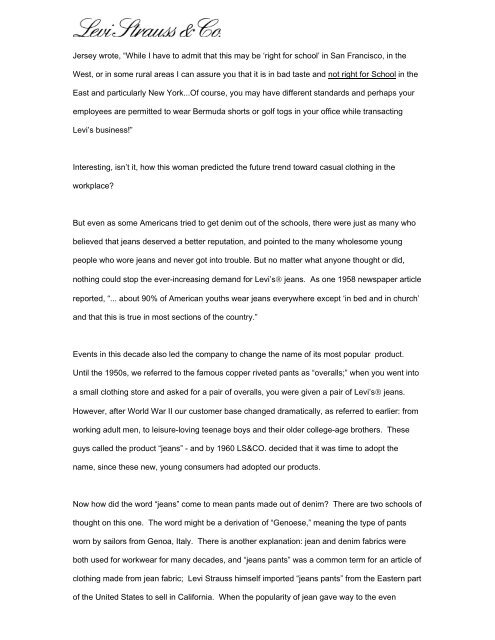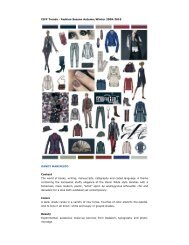Create successful ePaper yourself
Turn your PDF publications into a flip-book with our unique Google optimized e-Paper software.
Jersey wrote, “While I have to admit that this may be ‘right for school’ in San Francisco, in theWest, or in some rural areas I can assure you that it is in bad taste and not right for School in theEast and particularly New York...Of course, you may have different standards and perhaps youremployees are permitted to wear Bermuda shorts or golf togs in your office while transactingLevi’s business!”Interesting, isn’t it, how this woman predicted the future trend toward casual clothing in theworkplace?But even as some Americans tried to get denim out of the schools, there were just as many whobelieved that jeans deserved a better reputation, and pointed to the many wholesome youngpeople who wore jeans and never got into trouble. But no matter what anyone thought or did,nothing could stop the ever-increasing demand for Levi’s® jeans. As one 1958 newspaper articlereported, “... about 90% of American youths wear jeans everywhere except ‘in bed and in church’and that this is true in most sections of the country.”Events in this decade also led the company to change the name of its most popular product.Until the 1950s, we referred to the famous copper riveted pants as “overalls;” when you went intoa small clothing store and asked for a pair of overalls, you were given a pair of Levi’s® jeans.However, after World War II our customer base changed dramatically, as referred to earlier: fromworking adult men, to leisure-loving teenage boys and their older college-age brothers. Theseguys called the product “jeans” - and by 1960 LS&CO. decided that it was time to adopt thename, since these new, young consumers had adopted our products.Now how did the word “jeans” come to mean pants made out of denim? There are two schools ofthought on this one. The word might be a derivation of “Genoese,” meaning the type of pantsworn by sailors from Genoa, Italy. There is another explanation: jean and denim fabrics wereboth used for workwear for many decades, and “jeans pants” was a common term for an article ofclothing made from jean fabric; Levi Strauss himself imported “jeans pants” from the Eastern partof the United States to sell in California. When the popularity of jean gave way to the even



